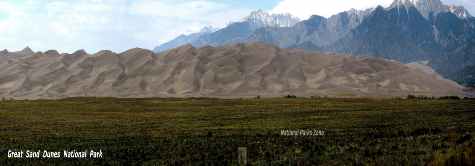Great Sand Dunes National Park
Great Sand Dunes, situated in a remote part of south western Colorado, is home to a 30-
Colorado
2013
About The Park
Great Sand Dunes National Park is one of those destination parks. It's not a park that's easy to get to or one that you might be driving in the area and stop in to check it out. It's in the corner of Colorado that's not served by any major roads or cities of any size.
That's not to say that the park doesn't have it's interesting points. The national
park is at the end of a 30 mile long sand dune with Star Dune rising to a height of 750 feet. It's the largest and the highest sand dune in the United States. It surpasses Death Valley’s Eureka Dunes by about 70 feet.
The sand, which originated in the San Juan Mountains, about 65 miles to the west, has been carried by wind and water for, estimates range from, somewhere between 12,000 and 1 million years. They have been deposited at the base of the San Christo Mountains.
Some of the formations were interesting and one made for a very unusual picture. It was a depression in the dune that was actually a rather large, deep hole and the (tiny) man pictured standing on the edge of it gave perspective to its size. It is included in the photo gallery page.
At the base of the dunes there's Medano Creek, a very shallow creek when we were there in early September, that we were able to cross by picking our way from sandbar to sandbar without having to take our boots off. At other times of the year, according to the pictures I saw, the river is somewhat more substantial but still no more than wading depth. For the locals the national park is a playground for them much like the beach is to people on the eastern seaboard. The kids play in the water, climb the dunes, and bring boogie boards to slide down the slopes of the dunes.
The national park visitor’s center was modern with the usual displays relating to the geology of the dunes and wildlife native to the area. It is at the base of the dunes and the elevation is 8,175 feet so the park is from that elevation up the mountains to about 10,000 feet.
Wildlife
There were lots of mule deer in the area. Some small herds of one or two dozen scattered around. Other wildlife found in the area are bighorn sheep, black bear, pronghorn, elk, cougar, beaver, yellow-
Lodging and Dining
Great Sand Dunes Lodge
The only accommodations in the area of the park was a small motel, the Great Sand Dunes Lodge, just outside the entrance to the park. The rooms were clean and neat with the usual amenities and a little patio, with tables and chairs, facing the dunes. There was an indoor pool and a continental breakfast. There is a small restaurant walking distance from the motel but unfortunately it was closed during the time we were there. For some reason they put off opening it for a few days and that left us without many options for dinner. Knowing that there was nothing for 25 or 30 miles in any direction from the lodge, and having been apprised of the restaurants delayed opening before we got there, we picked up some microwaveable food in Alamosa, Colorado and we made do with that for a couple of nights. One night we did drive into Blanca, Colorado and had dinner at a Mexican restaurant there. Unfortunately the quality of the food left something to be desired.
Hiking
There are no marked hiking trails on the dunes. You just walk up where ever you want. Any ‘trail’ would be obliterated by the winds. You can also camp on the dunes if you want but a hike on them was sufficient for us. Hiking up the dunes was easy in some places, the surface was very firm, and in other places it was more tiring -
There are some trails near the visitor center that head up the Sangre De Christo Mountains across Medano Creek at the end of the dunes.
You can also hike up the surrounding mountains in the Rio Grande National Forest which borders the park. There was a nice hike up to a waterfall a few miles down the road from the park in this national forest.
Off Road Driving
There’s an off-
Great Sand Dunes National Park Photo Gallery
Other Resources
Great Sand Dunes National Park on the National Parks Service website -

Other National Parks and National Monuments Within a Day’s Drive
Mesa Verde National Park the world famous home of cliff dwellings of the Anasazi is about 220 miles to the west and about 4.5 hours.
Black Canyon of the Gunnison National Park This spectacular canyon is 202 miles southeast and about a 4 hour drive.
Canyonlands National Park and Arches National Park These are places of steep canyons and iconic arches and are both outside of Moab, Utah and are about 330 miles to the northwest and about a 6 hour drive.
Petrified Forest National Park Home of the Painted Desert and 225 million year old petrified logs is 415 miles to the southwest and about 7.5 hours.
These national monuments are on Navajo Tribal land and are as worthwhile to visit as any national park.
Monument Valley Tribal Park Famous for its massive sandstone buttes and as a backdrop for many a Hollywood western movie is about 355 miles west and about a 6 hour drive.
Canyon De Chelly National Monument Ancient cliff dwellings carved into the sides of a steep canyon is about 365 miles southwest and about a 7 hour drive.
*N*P*Z*

Updated 02/11/23 7:04 PM
National Parks Zone